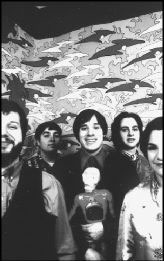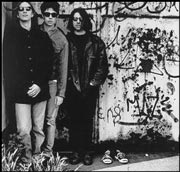SHANNON WRIGHT WITH SONGS:OHIA, STRAUDHAUGHTON ECHO
Paradox, 524-7677, $8 8 p.m. Tues., Nov. 13
PART OF Shannon Wright enjoys making people cry. When I tell her that I’ve witnessed audience members actually leaving her performances in tears, the Atlanta-based singer/songwriter (and former frontperson for Florida pop darlings Crowsdell) counters with a long laugh.
“That makes me feel really good,” she says in a Southern drawl that’s charming even over a murky long- distance phone line. “That’s what music does for me. How often are we driven by all this bullshit in life? But if we can come together and feel this way in a room with a small amount of people. . . . It’s not a negative thing.”
But Wright is not a callous misanthrope with little regard for the feelings of others. Actually, she’s quite the opposite. As a performer and as an artist, Wright takes a perverse pleasure in exposing the raw, bloody emotions that make up daily human existence. On her third solo record, Dyed in the Wool (released last August on Quarterstick), Wright dives headlong into her own darkness, dragging frantic passions and evil demons into the light. It feels intensely personal because it is: She sacrifices herself so that others might find recognition in her experiences.
“I think we all feel the same, but we get no credit that we are so similar and have similar emotions,” she explains. “People don’t want to feel [the way I make them feel] because they don’t think they have those emotions inside them. And I respect that, but I think people that are open appreciate it. It’s not necessarily saying, ‘Hey, here’s this sorrow!’ but that you’re not alone.”
Indeed, the tone of Dyed in the Wool makes for both a familiar and disquieting listen. More aggressive than her 1999 debut, Flightsafety, and less jagged than 2000’s Maps of Tacit, Dyed in the Wool highlights Wright’s stark and beautiful voice as it attempts to howl its way out of the blackness. Her tales of despair and isolation are projected on stunning instrumental work by members of Man or Astro-man?, Rachel’s, and the Glands, among others, and her own crazed circus of guitar and piano. Dynamic tracks like “Hinterland” and “The Path of Least Persistence (Figure II)” practically split themselves down the middle in an attempt to show their innards, while deeper, quieter moments like “Method of Sleeping” seem to cower in corners, clutching security blankets with wide eyes.
Wright mirrors the unpredictable emotional tilts of the record in her live performance. Onstage, she loses her capitals and calm demeanor and becomes shannonwright. Lurching over her guitar and stomping her feet, she fumes with the rage of an abused child and then, in moments of calm, she caresses her piano gently while an eerie display panel illuminates the notes in red flashing light. She is an unknowable and volatile other—the Dr. Jeckyll/Mr. Hyde of indie rock.
“I think we’re all that way,” she says. “We all have a side to us that’s very intense. I just let that side come out. It doesn’t mean I’m a bad person or that I’m mean. It’s also the side of us that’s hopeful and beautiful. It’s not all negative. Also, being a woman, it’s like, ‘She’s scary!’ It probably is scary. I have no idea because I’m just being me.”
Wright doesn’t balk at being considered a frightening performer. In fact, she treats the whole thing rather glibly, even referring to herself as a monster. All kidding aside, the truth is that Wright’s performances can be scary. But that quality also makes them intense and real. Like a car accident, she gives us a chance to stare at blatant human wreckage: it’s horrific, painful, and utterly enthralling.
“It is a very intense show,” she says. “I’m so driven by being honest that it keeps me on. I get angry onstage if something distracts me or if something’s not technically going right or interrupting what I want to do. I take it so seriously and I want it to be so honest and true for the audience. I don’t want to be thinking about anything but the songs.”








